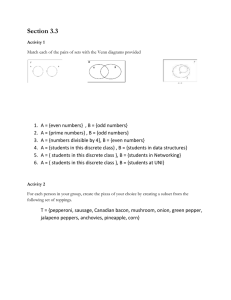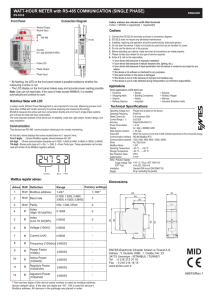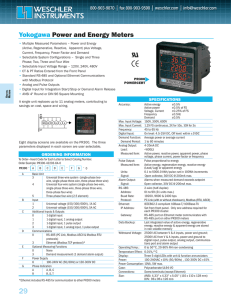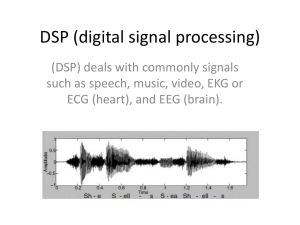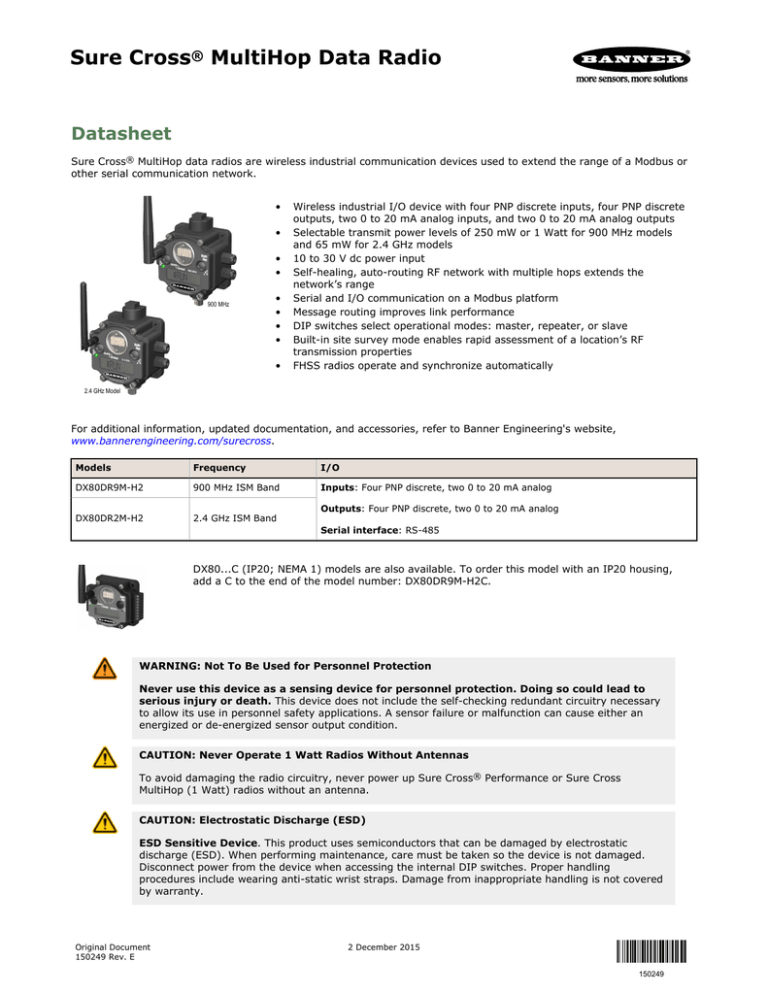
Sure Cross® MultiHop Data Radio
Datasheet
Sure Cross® MultiHop data radios are wireless industrial communication devices used to extend the range of a Modbus or
other serial communication network.
•
•
•
•
900 MHz
•
•
•
•
•
Wireless industrial I/O device with four PNP discrete inputs, four PNP discrete
outputs, two 0 to 20 mA analog inputs, and two 0 to 20 mA analog outputs
Selectable transmit power levels of 250 mW or 1 Watt for 900 MHz models
and 65 mW for 2.4 GHz models
10 to 30 V dc power input
Self-healing, auto-routing RF network with multiple hops extends the
network’s range
Serial and I/O communication on a Modbus platform
Message routing improves link performance
DIP switches select operational modes: master, repeater, or slave
Built-in site survey mode enables rapid assessment of a location’s RF
transmission properties
FHSS radios operate and synchronize automatically
2.4 GHz Model
For additional information, updated documentation, and accessories, refer to Banner Engineering's website,
www.bannerengineering.com/surecross.
Models
Frequency
I/O
DX80DR9M-H2
900 MHz ISM Band
Inputs: Four PNP discrete, two 0 to 20 mA analog
DX80DR2M-H2
2.4 GHz ISM Band
Outputs: Four PNP discrete, two 0 to 20 mA analog
Serial interface: RS-485
DX80...C (IP20; NEMA 1) models are also available. To order this model with an IP20 housing,
add a C to the end of the model number: DX80DR9M-H2C.
WARNING: Not To Be Used for Personnel Protection
Never use this device as a sensing device for personnel protection. Doing so could lead to
serious injury or death. This device does not include the self-checking redundant circuitry necessary
to allow its use in personnel safety applications. A sensor failure or malfunction can cause either an
energized or de-energized sensor output condition.
CAUTION: Never Operate 1 Watt Radios Without Antennas
To avoid damaging the radio circuitry, never power up Sure Cross® Performance or Sure Cross
MultiHop (1 Watt) radios without an antenna.
CAUTION: Electrostatic Discharge (ESD)
ESD Sensitive Device. This product uses semiconductors that can be damaged by electrostatic
discharge (ESD). When performing maintenance, care must be taken so the device is not damaged.
Disconnect power from the device when accessing the internal DIP switches. Proper handling
procedures include wearing anti-static wrist straps. Damage from inappropriate handling is not covered
by warranty.
Original Document
150249 Rev. E
2 December 2015
150249
Sure Cross® MultiHop Data Radio
MultiHop Configuration Tool
Use Banner’s MultiHop Configuration Tool software to view your MultiHop radio network and configure the radio and its
I/O.
The MultiHop Configuration Tool requires that you connect your master radio to
your computer using either a USB to RS-485 (for RS-485 radios) or a USB to
RS-232 (for RS-232 radios) converter cable. For RS-485 models, Banner
recommends using cable model BWA-UCT-900, an RS-485 to USB adapter cable
with a wall plug that can power your 1 Watt MultiHop radio while you are
configuring it.
If you use an adapter cable that does not also supply 10-30V dc to your radio,
use the DIP switches to set the MultiHop Radio to transmit at 250 mW.
When the MultiHop Configuration Tool launches, it automatically checks to see if a newer version of the software is
available. If a newer version is available, a dialog box displays on the screen to ask you if you want to download the new
version or ignore the new version. If you select download, the newer version automatically downloads, installs, and
relaunches the program for you.
Setting Up Your MultiHop Network
To set up and install your wireless MultiHop network, follow these steps:
1. If your radios have DIP switches, configure the DIP switches of all devices.
2. Connect the sensors to the MultiHop radios if applicable.
3. Apply power to all devices.
4. If your MultiHop radio has rotary dials, set the MultiHop Radio (Slave) ID. If your MultiHop radio has no rotary dials,
continue to the next step.
5. Form the wireless network by binding the slave and repeater radios to the master radio. If the binding instructions are
not included in this datasheet, refer to the quick start guide or product manual.
6. Observe the LED behavior to verify the devices are communicating with each other.
7. Conduct a site survey between the MultiHop radios. If the site survey instructions are not included in this datasheet,
refer to the product manual.
8. Install your wireless sensor network components. If the installation instructions are not included in this datasheet, refer
to the product manual.
For additional information, including installation and setup, weatherproofing, device menu maps, troubleshooting, and a
list of accessories, refer to one of the following product manuals:
• MultiHop Radio Quick Start Guide: 152653
• MultiHop Radio Product Manual: 151317
• MultiHop Register Guide (End User Edition): 155289
Configure the DIP Switches
Before making any changes to the DIP switch positions, disconnect the power. DIP switch changes will not be recognized if
power isn't cycled to the device.
Accessing the Internal DIP Switches
To access the internal DIP switches, follow these steps:
1. Unscrew the four screws that mount the cover to the bottom housing.
2. Remove the cover from the housing without damaging the ribbon cable or the pins the cable plugs into.
3. Gently unplug the ribbon cable from the board mounted into the bottom housing.
4. Remove the black cover plate from the bottom of the device's cover.
The DIP switches are located behind the rotary dials.
2
www.bannerengineering.com - Tel: +1-763-544-3164
P/N 150249 Rev. E
Sure Cross® MultiHop Data Radio
After making the necessary changes to the DIP switches, place the black cover plate back into
position and gently push into place. Plug the ribbon cable in after verifying that the blocked hole
lines up with the missing pin. Mount the cover back onto the housing.
DIP Switch Settings (MultiHop)
Switches
Device Settings
3
4
Parity: None
OFF*
OFF*
Parity: Even
OFF
ON
Parity: Odd
ON
OFF
Disable serial (low power mode) and enable the
receiver slots select for switches 1-2
ON
ON
Serial line baud rate 19200 OR User defined receiver
slots
1
2
OFF*
OFF*
Serial line baud rate 38400 OR 32 receiver slots
OFF
ON
Serial line baud rate 9600 OR 128 receiver slots
ON
OFF
Serial line baud rate Custom OR 4 receiver slots
ON
ON
Transmit power
5
6
7
8
OFF*
900 MHz radios: 1.00 Watt (30 dBm)
2.4 GHz radios: 0.065 Watts (18 dBm) and 60 ms
frame
Transmit power
ON
900 MHz radios: 0.25 Watts (24 dBm)
2.4 GHz radios: 0.065 Watts (18 dBm) and 40 ms
frame
Application mode: Modbus
OFF*
Application mode: Transparent
ON
MultiHop radio setting: Repeater
OFF*
OFF*
MultiHop radio setting: Master
OFF
ON
MultiHop radio setting: Slave
ON
OFF
MultiHop radio setting: Reserved
ON
ON
* Default configuration
Application Mode
The MultiHop radio operates in either Modbus mode or transparent mode. Use the internal DIP switches to select the mode
of operation. All MultiHop radios within a wireless network must be in the same mode.
Modbus mode uses the Modbus protocol for routing packets. In Modbus mode, a routing table is stored in each parent
device to optimize the radio traffic. This allows for point to point communication in a multiple data radio network and
acknowledgement/retry of radio packets. To access a radio's I/O, the radios must be running in Modbus mode.
In transparent application mode, all incoming packets are stored, then broadcast to all connected data radios. The data
communication is packet based and not specific to any protocol. The application layer is responsible for data integrity. For
one to one data radios it is possible to enable broadcast acknowledgement of the data packets to provide better
throughput. In transparent mode, there is no access to the radio's I/O.
Baud Rate and Parity
The baud rate (bits per second) is the data transmission rate between the device and whatever it is physically wired to.
Set the parity to match the parity of the device you are wired to.
Disable Serial
If the local serial connection is not needed, disable it to reduce the power consumption of a data radio powered from the
solar assembly or from batteries. All radio communications remain operational.
P/N 150249 Rev. E
www.bannerengineering.com - Tel: +1-763-544-3164
3
Sure Cross® MultiHop Data Radio
Receiver Slots
The number of receiver slots indicates the number of times out of 128 slots/frames the radio can transmit to its parent
radio. Setting a slave’s receiver slots to 4 reduces the total power consumption by establishing that the slave can only
transmit to its parent four times per 128 slots.
Transmit Power Levels/Frame Size
The 900 MHz data radios can be operated at 1 watt (30 dBm) or 0.250 watt (24 dBm). For most models, the default
transmit power is 1 watt.
For 2.4 GHz radios, the transmit power is fixed at 0.065 watt (18 dBm) and DIP switch 5 is used to set the frame timing.
The default position (OFF) sets the frame timing to 60 milliseconds. To increase throughput, set the frame timing to 40
milliseconds. Note that increasing the throughput decreases the battery life.
Prior to date code 15341 and radio firmware version 3.6, the frame timing was 40 ms (OFF) or 20 ms (ON).
Wiring Your Sure Cross® Device
Use the following wiring diagrams to first wire the sensors and then apply power to the Sure Cross devices.
Wiring Power and Ground
Connecting dc power to the communication pins will cause permanent damage.
5-pin M12/Euro-style Male Connector
1
2
4
5
3
Pin
Wire Color
Wiring Description
1
Brown
10 to 30 V dc
2
White
RS-485 / D1 / B / +
3
Blue
dc common (GND)
4
Black
RS-485 / D0 / A / -
5
Gray
-
Wiring for DX80...M-HxC Models for Power and Ground
Connecting dc power to the communication pins will cause permanent damage.
Terminal
V+
Tx/+
10 to 30 V dc
RS-485 / D1 / B / +
V-
dc common (GND)
Rx/-
RS-485 / D0 / A / -
B+
4
Wiring Description
-
www.bannerengineering.com - Tel: +1-763-544-3164
P/N 150249 Rev. E
Sure Cross® MultiHop Data Radio
Wiring Diagrams (IP67 Models)
GND GND
PWR
PWR
Discrete Input Wiring for NPN Sensors
PWR
PWR
Discrete Input Wiring for PNP Sensors
GND GND
AO2 AI2
AO1 AI1
−
+
−
+
−
+
−
+
AO2 AI2
AO1 AI1
Load
DO4 DI4
Load
DO4 DI4
Load
DO3 DI3
Load
DO3 DI3
Load
DO2 DI2
Load
DO2 DI2
Load
DO1 DI1
Load
DO1 DI1
AIx or Ax. Analog IN x
AOx. Analog OUT x
DIx. Discrete IN x
DOx. Discrete OUT x
GND. Ground/dc common connection
PWR. 10 to 30 V dc power connection
Wiring Diagrams (IP20 Models)
Connecting dc power to the communication pins will cause permanent damage.
PNP Discrete Inputs
+
+
−
−
+
10-30V dc
−
DI1
DI2
DI3
DI4
AI1
AI2
V+
VV-
DO1
DO2
DO3
DO4
AO1
AO2
Tx/+
Rx/V+
NPN Discrete Inputs
Load
Load
Load
Load
RS-485+
RS-485−
AIx or Ax. Analog IN x
AOx. Analog OUT x
DIx. Discrete IN x
DIx. Discrete IN x
DOx. Discrete OUT x
GND. Ground/dc common connection
+
−
+
−
+
10-30V dc
−
DI1
DI2
DI3
DI4
AI1
AI2
V+
VV-
DO1
DO2
DO3
DO4
AO1
AO2
Tx/+
Rx/V+
Load
Load
Load
Load
RS-485+
RS-485−
PWR. 10 to 30 V dc power connection
RX/-. Serial communication line for the Gateway. No
connection for Nodes
TX/+. Serial communication line for the Gateway; no
connection for Nodes
V+. 10 to 30 V dc power connection
V–. Ground/dc common connection
Set the MultiHop Radio (Slave) ID
On a MultiHop radio, use the rotary dials to set the device’s MultiHop Radio ID.
Modbus Slave IDs 01 through 10 are reserved for slaves directly connected to the host (local
I/O). Polling messages addressed to these devices are not relayed over the wireless link. Use
Modbus Slave IDs 11 through 60 for MultiHop master, repeater, and slave radios. Up to 50
devices (local slaves and remote slaves) may be used in this system.
With the left dial acting as the left digit and the right dial acting as the right digit, the
MultiHop Radio ID can be set from 01 through 60.
P/N 150249 Rev. E
www.bannerengineering.com - Tel: +1-763-544-3164
5
Sure Cross® MultiHop Data Radio
Modbus Register Table
Register
(4xxxx)
Input #
I/O Type
I/O Range
Holding Register
Representation
Terminal
Min. Value
Max. Value
Min. (Dec.)
Max.
(Dec.)
1
1
Discrete IN 1
0
1
0
1
DI1
2
2
Discrete IN 2
0
1
0
1
DI2
3
3
Discrete IN 3
0
1
0
1
DI3
4
4
Discrete IN 4
0
1
0
1
DI4
5
5
Analog IN 1 (mA)
0.0
20.0
0
65535
AI1
6
6
Analog IN 2 (mA)
0.0
20.0
0
65535
AI2
Register
(4xxxx)
Output # I/O Type
I/O Range
Holding Register
Representation
Terminal
Min. Value
Max. Value
Min.
(Dec.)
Max. (Dec.)
501
1
Discrete OUT 1
0
1
0
1
DO1
502
2
Discrete OUT 2
0
1
0
1
DO2
503
3
Discrete OUT 3
0
1
0
1
DO3
504
4
Discrete OUT 4
0
1
0
1
DO4
505
5
Analog OUT 1 (mA)
0.0
20.0
0
65535
AO1
506
6
Analog OUT 2 (mA)
0.0
20.0
0
65535
AO2
Modbus Addressing Convention
All Modbus addresses refer to Modbus holding registers. When writing your own Modbus scripts, use the appropriate
commands for interfacing to holding registers. Parameter description headings refer to addresses in the range of 40000 as
is customary with Modbus convention.
Modbus Register Configuration
Change the factory default settings for the inputs, outputs, and device operations using the device Modbus registers. To
change parameters, set the data radio network to Modbus mode and assign the data radio a valid Modbus slave ID.
Generic input or output parameters are grouped together based on the device input or output number: input 1, input 2,
output 1 etc. Operation type specific parameters (discrete, counter, analog 4 to 20 mA) are grouped together based on the
I/O type number: analog 1, analog 2, counter 1, etc. Not all inputs or outputs may be available for all models. To
determine which specific I/O is available on your model, refer to the Modbus Input/Output Register Maps listed in the
device's datasheet. For more information about registers, refer to the MultiHop Product Manual (p/n 151317).
Factory Default Configuration
Discrete Inputs (PNP)
6
Enable
Sample
Boost
Enable
Boost
Warmup
Boost
Voltage
Extended
Input Read
NPN/PNP
Sample
High
Sample
Low
ON
40 ms
OFF
OFF
OFF
OFF
PNP
OFF
OFF
www.bannerengineering.com - Tel: +1-763-544-3164
P/N 150249 Rev. E
Sure Cross® MultiHop Data Radio
Analog Inputs
Enable
Sample
Boost
Enable
Boost
Warmup
Boost
Voltage
Extended
Input Read
Analog Max
Analog Min
Enable
Fullscale
ON
1 sec
OFF
OFF
OFF
OFF
20000
0
ON
Discrete Outputs
Enable
Flash Enable
ON
OFF
Analog Outputs
Enable
Analog Max
Analog Min
Enable Fullscale
Hold Last State
Enable
Default Output
State
ON
20000
0
ON
OFF
0
Specifications
Radio Range1
900 MHz, 1 Watt: Up to 9.6 km (6 miles)
2.4 GHz, 65 mW: Up to 3.2 km (2 miles)
Supply Voltage
10 to 30 V dc (Outside the USA: 12 to 24 V dc, ±10%). 2
Minimum Separation Distance
900 MHz, 1 Watt: 4.57 m (15 ft)
2.4 GHz, 65 mW: 0.3 m (1 ft)
Radio Transmit Power
900 MHz, 1 Watt: 30 dBm (1 W) conducted (up to 36 dBm EIRP)
2.4 GHz, 65 mW: 18 dBm (65 mW) conducted, less than or equal to 20
dBm (100 mW) EIRP
900 MHz Compliance (1 Watt)
FCC ID UE3RM1809: This device complies with FCC Part 15, Subpart C,
15.247
IC: 7044A-RM1809
2.4 GHz Compliance (MultiHop)
FCC ID UE300DX80-2400 - This device complies with FCC Part 15,
Subpart C, 15.247
ETSI EN 300 328: V1.8.1 (2012-04)
IC: 7044A-DX8024
Spread Spectrum Technology
FHSS (Frequency Hopping Spread Spectrum)
Power Consumption
Master radio consumption (900 MHz): Maximum current draw is < 100
mA and typical current draw is < 30 mA at 24 V dc. (2.4 GHz
consumption is less.)
Repeater/slave radio consumption (900 MHz): Maximum current draw
is < 40 mA and typical current draw is < 20 mA at 24 V dc. (2.4 GHz
consumption is less.)
Housing
Polycarbonate housing and rotary dial cover; polyester labels; EDPM
rubber cover gasket; nitrile rubber, non-sulphur cured button covers
Weight: 0.26 kg (0.57 lbs)
Mounting: #10 or M5 (SS M5 hardware included)
Max. Tightening Torque: 0.56 N·m (5 lbf·in)
Antenna Connection
Ext. Reverse Polarity SMA, 50 Ohms
Max Tightening Torque: 0.45 N·m (4 lbf·in)
Interface
Indicators: Two bi-color LEDs
Buttons: Two
Display: Six character LCD
Wiring Access
M-Hx models: Four PG-7, One 1/2-inch NPT, One 5-pin threaded M12/
Euro-style male quick disconnect
M-HxC models: External terminals
Communication Hardware (MultiHop RS-485)
Interface: 2-wire half-duplex RS-485
Baud rates: 9.6k, 19.2k (default), or 38.4k via DIP switches; 1200 and
2400 via the MultiHop Configuration Tool
Data format: 8 data bits, no parity, 1 stop bit
Packet Size (MultiHop)
900 MHz: 175 bytes (85 Modbus registers)
2.4 GHz: 75 bytes (37 Modbus registers)
Environmental Ratings3
M-Hx models: IEC IP67; NEMA 6 4
"C" Housing Models/External wiring terminals: IEC IP20; NEMA 1
Shock and Vibration
IEC 68-2-6 and IEC 68-2-27
Shock: 30g, 11 millisecond half sine wave, 18 shocks
Vibration: 0.5 mm p-p, 10 to 60 Hz
Conditions
–40 °C to +85 °C (–40 °F to +185 °F) (Electronics); –20 °C to +80 °C
(–4 °F to +176 °F) (LCD)
95% maximum relative humidity (non-condensing)
Radiated Immunity: 10 V/m (EN 61000-4-3)
Intercharacter Timing (MultiHop)
3.5 milliseconds
Certifications
1 Radio range is with the 2 dB antenna that ships with the product. High-gain antennas are available, but the range depends on the environment and line of
sight. To determine the range of your wireless network, perform a Site Survey.
2 For European applications, power the DX80 from a Limited Power Source as defined in EN 60950-1.
3 Operating the devices at the maximum operating conditions for extended periods can shorten the life of the device.
4 Refer to the Sure Cross® MultiHop Product Instruction Manual (p/n 151317) for installation and waterproofing instructions.
P/N 150249 Rev. E
www.bannerengineering.com - Tel: +1-763-544-3164
7
Sure Cross® MultiHop Data Radio
Discrete Inputs
Rating: 3 mA max current at 30 V dc
Sample Rate: 40 milliseconds
Discrete Outputs
Update Rate: 125 milliseconds
ON Condition: Supply minus 2 V
OFF Condition: Less than 2 V
Output State Following Timeout: OFF
Discrete Input ON Condition
PNP: Greater than 8 V
NPN: Less than 0.7 V
Discrete Output Rating (PNP)
100 mA max current at 30 V dc
ON-State Saturation: Less than 3 V at 100 mA
OFF-state Leakage: Less than 10 μA
Discrete Input OFF Condition
PNP: Less than 5 V
NPN: Greater than 2 V or open
Analog Outputs
Update Rate: 125 milliseconds
Accuracy: 0.1% of full scale +0.01% per °C
Resolution: 12-bit
Analog Inputs
Rating: 24 mA
Impedance: Approx. 100 Ohms 5
Sample Rate: 1 second
Accuracy: 0.1% of full scale +0.01% per °C
Resolution: 12-bit
Included with Model
The following items ship with the DX80 radios.
•
•
•
•
•
•
•
BWA-HW-002: DX80 Access Hardware Kit, containing four PG-7 plastic threaded plugs, four PG-7 nylon gland
fittings, four PG-7 hex nuts, one 1/2-inch NPT plug, and one 1/2-inch nylon gland fitting. (Not included with IP20
DX80...C models)
BWA-HW-001: Mounting Hardware Kit, containing four M5-0.8 x 25mm SS screws, four M5-0.8 x 16mm SS screws,
four M5-0.8mm SS hex nuts, and four #8-32 x 3/4" SS bolts
BWA-HW-003: PTFE tape
BWA-9O2-C (900 MHz) or BWA-2O2-C (2.4 GHz): Antenna, 2 dBd Omni, Rubber Swivel RP-SMA Male. (Not
included with Internal antenna models)
Quick Start Guide (128185 for DX80 Gateways or 152653 for MultiHop models)
MQDC1-506: 5-Euro (single ended) straight cable, 2m (Not included with FlexPower devices)
BWA-HW-011: IP20 Screw Terminal Headers (2 pack) (Included only with the IP20 DX80...C models)
Warnings
Antenna Installations. Install and properly ground a qualified surge suppressor when installing a remote antenna system. Remote antenna configurations
installed without surge suppressors invalidate the manufacturer's warranty. Keep the ground wire as short as possible and make all ground connections to a single-point
ground system to ensure no ground loops are created. No surge suppressor can absorb all lightning strikes; do not touch the Sure Cross® device or any equipment
connected to the Sure Cross device during a thunderstorm.
Exporting Sure Cross® Radios. It is our intent to fully comply with all national and regional regulations regarding radio frequency emissions. Customers who want to
re-export this product to a country other than that to which it was sold must ensure the device is approved in the destination country. A list of approved
countries appears in the Radio Certifications section of the product manual. The Sure Cross wireless products were certified for use in these countries using the antenna that
ships with the product. When using other antennas, verify you are not exceeding the transmit power levels allowed by local governing agencies. Consult with Banner
Engineering Corp. if the destination country is not on this list.
Violating Warnings. The manufacturer does not take responsibility for the violation of any warning listed in this document. Make no modifications to this product; any
modifications to this product not expressly approved by Banner Engineering could void the user’s authority to operate the product. All specifications published in this
document are subject to change; Banner reserves the right to modify product specifications or update documentation at any time. For the most recent version of any
documentation, refer to: www.bannerengineering.com. © Banner Engineering Corp. All rights reserved.
Banner Engineering Corp. Limited Warranty
Banner Engineering Corp. warrants its products to be free from defects in material and workmanship for one year following the date of shipment. Banner Engineering Corp.
will repair or replace, free of charge, any product of its manufacture which, at the time it is returned to the factory, is found to have been defective during the warranty
period. This warranty does not cover damage or liability for misuse, abuse, or the improper application or installation of the Banner product.
THIS LIMITED WARRANTY IS EXCLUSIVE AND IN LIEU OF ALL OTHER WARRANTIES WHETHER EXPRESS OR IMPLIED (INCLUDING, WITHOUT LIMITATION,
ANY WARRANTY OF MERCHANTABILITY OR FITNESS FOR A PARTICULAR PURPOSE), AND WHETHER ARISING UNDER COURSE OF PERFORMANCE, COURSE
OF DEALING OR TRADE USAGE.
This Warranty is exclusive and limited to repair or, at the discretion of Banner Engineering Corp., replacement. IN NO EVENT SHALL BANNER ENGINEERING CORP. BE
LIABLE TO BUYER OR ANY OTHER PERSON OR ENTITY FOR ANY EXTRA COSTS, EXPENSES, LOSSES, LOSS OF PROFITS, OR ANY INCIDENTAL,
CONSEQUENTIAL OR SPECIAL DAMAGES RESULTING FROM ANY PRODUCT DEFECT OR FROM THE USE OR INABILITY TO USE THE PRODUCT, WHETHER
ARISING IN CONTRACT OR WARRANTY, STATUTE, TORT, STRICT LIABILITY, NEGLIGENCE, OR OTHERWISE.
Banner Engineering Corp. reserves the right to change, modify or improve the design of the product without assuming any obligations or liabilities relating to any product
previously manufactured by Banner Engineering Corp.
5 To verify the analog input's impedance, use an Ohm meter to measure the resistance between the analog input terminal (AIx) and the ground (GND)
terminal.
www.bannerengineering.com - Tel: +1-763-544-3164

